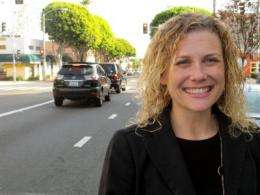Researcher finds proximity to freeway associated with autism

Living near a freeway may be associated with increased risk of autism, according to a study published by a team of researchers from Children's Hospital Los Angeles, the Keck School of Medicine of the University of Southern California (USC) and the UC Davis MIND Institute.
The paper will appear online in the journal Environmental Health Perspectives this week.
"Children born to mothers living within 309 meters of a freeway appeared to be twice as likely to have autism," said Heather Volk, PhD, MPH, and first author on the study. Dr. Volk holds a joint appointment at the Community, Health Outcomes & Intervention Research Program at The Saban Research Institute of Children's Hospital Los Angeles, the Zilkha Neurogenetic Institute and the Department of Preventative Medicine at USC.
Autism is a developmental disorder that has long been ascribed to genetic factors. While changes in diagnostic criteria and increased awareness have been thought to contribute to the rising incidence of the disorder, these factors alone cannot explain the dramatic increase in the number of children affected. The Centers for Disease Control reported a 57 percent increase between 2002 and 2006. This study supports the theory that environmental factors, in conjunction with a strong genetic risk, may be one possible explanation for the increase.
While little is known about the role of environmental pollutants on autism, air pollution exposure during pregnancy has been seen to have physical and developmental effects on the fetus in other studies. Exposure to air pollution during the first months of life has also been linked to cognitive developmental delay. However, the authors said that this study is the first to link exposure to vehicular pollutants with autism risk, though direct measurements of pollutants were not made.
Data from children with autism and typically developing children, who served as controls, were drawn from the Childhood Autism Risks from Genetics and the Environment (CHARGE) study, a population-based case-control study of preschool children. Children were between the ages of 24 and 60 months at the start of the study and lived in communities around Los Angeles, San Francisco and Sacramento. Population-based controls were recruited from state of California birth files, and were frequency matched to the autism cases by age, gender, and broad geographic area. Each participating family was evaluated in person. All children were assessed; assessment of autism was done using well-validated instruments.
The study examined the locations where the children's families' lived during the first, second and third trimesters of their mothers' pregnancies, and at the time of the baby's birth and looked at the proximity of these homes to a major road or freeway. The participants' gestational ages were determined using ultrasound measurements and prenatal records.
Dr. Volk and her colleagues found that living within 309 meters of a freeway (or just over 1000 feet) at birth was associated with a two-fold increase in autism risk. This association was not altered by adjustment for child gender or ethnicity, maximum education in the home, maternal age, or prenatal smoking. The researchers found no consistent pattern of association of autism with proximity to a major road.
Traffic-related air pollutants have been observed to induce inflammation and oxidative stress in toxicological and human studies. The emerging evidence that oxidative stress and inflammation are involved in the pathogenesis of autism supports the findings of this study.
"We expect to find many, perhaps dozens, of environmental factors over the next few years, with each of them probably contributing to a fraction of autism cases. It is highly likely that most of them operate in conjunction with other exposures and/or with genes," said Irva Hertz-Picciotto, PhD, chief of the division of environmental and occupational health in the Department of Public Health Sciences at UC Davis, and principal investigator on the CHARGE study.















